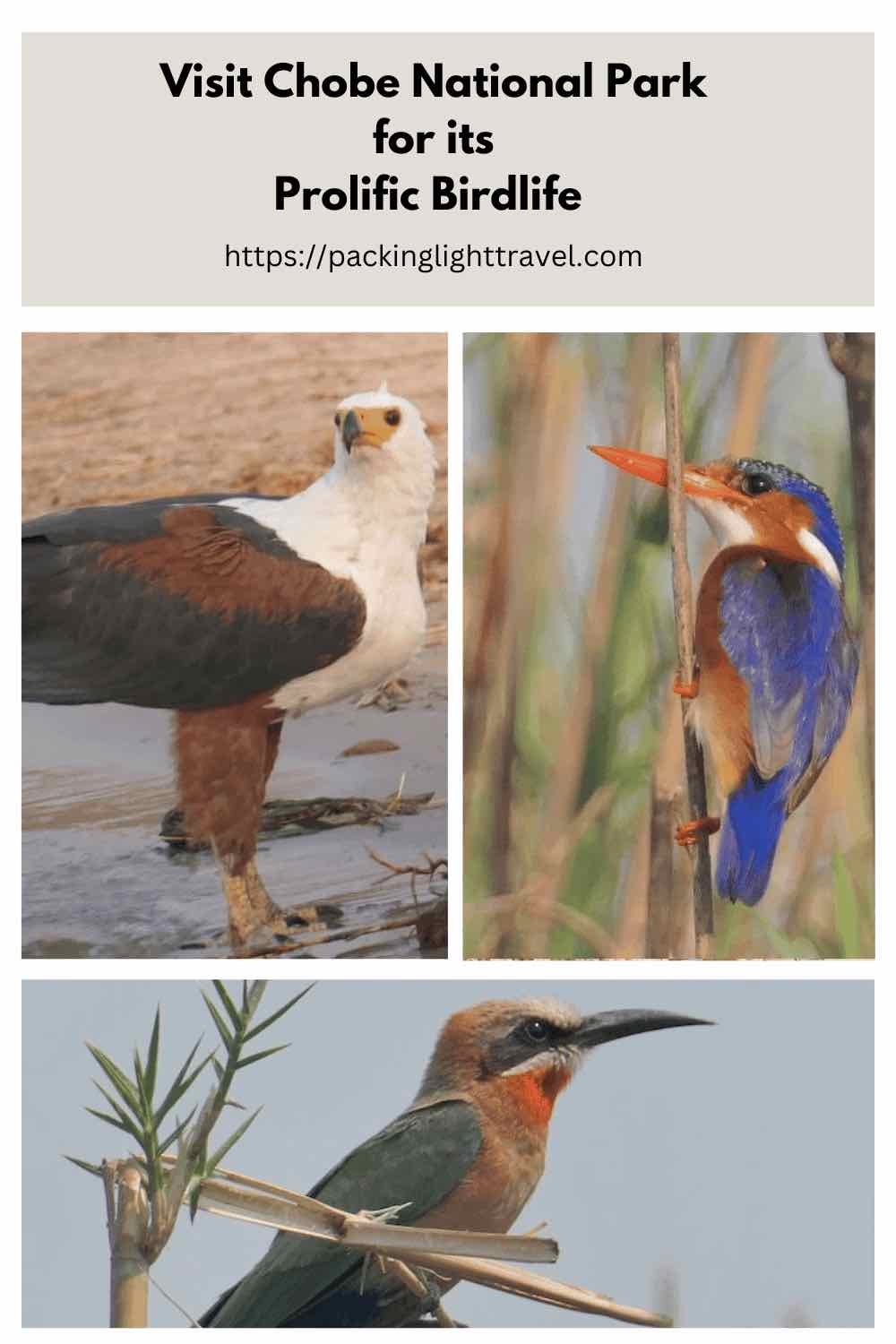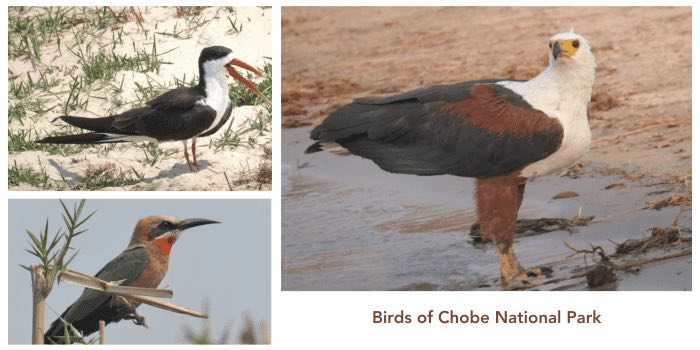Chobe National Park is a popular wildlife-viewing destination. It’s recognized as the home to the world’s largest elephant population. However, the park is also renowned as a birdwatchers’ paradise with over 460 recorded avian species. While not a complete collection of sightings during my three-day visit, here is a photo gallery of sixteen birds of Chobe National Park you can expect to see on a water safari along the Chobe River.
Table of Contents
- Where is the Chobe National Park?
- The best time to visit the Chobe National Park
- My Chobe National Park experience
- 16 Remarkable birds of Chobe National Park
- 1. African darter
- 2. African fish eagle
- 3. African jacana
- 4. African skimmer
- 5. Black-crowned night heron
- 6. Black-winged stilt
- 7. Grey heron
- 8. Malachite kingfisher
- 9. Pied kingfisher
- 10. Red-billed oxpecker
- 11. Water thick-knee
- 12. White-breasted cormorant
- 13. White-crowned lapwing
- 14. White-fronted bee-eater
- 15. Wire-tailed swallow
- 16. Yellow-billed stork
- The verdict?
Where is the Chobe National Park?
Situated in Northern Botswana, the park also borders Namibia.
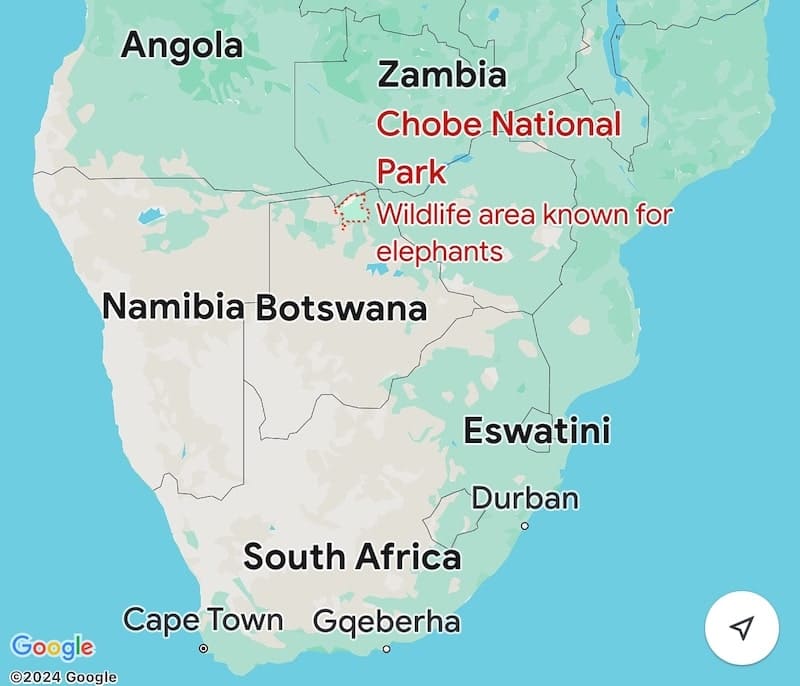
The Chobe River forms the park’s northern boundary. The river is the region’s lifeblood, providing a year-round water source for the multitude of mammals, reptiles, and birds that call the park home. The surrounding floodplains and woodland offer an assortment of habitats supporting one of Africa’s greatest concentrations of game.
The gateway to the park is Kasane, a small town near the borders of Zimbabwe, Zambia, and Namibia. Kasane (Botswana) is only 80 kilometres from Victoria Falls (Zimbabwe), so the park attracts many day visitors who combine game drives and boat tours to view the abundant wildlife. Those staying longer can choose from various accommodations, including tented camps, luxury lodges, and houseboats. The Kasane Airport makes the park accessible to visitors.
The best time to visit the Chobe National Park
Wildlife viewing is a year-round activity. The Chobe National Park dramatically changes from season to season. The floodplains of the wet season between December and April attract a wider variety of bird species and herbivores in search of lush vegetation. During the dry season from May to November, many water-dependent animals such as elephants, buffalo, crocodiles, and hippopotamus can be spotted along the river.
My Chobe National Park experience
I visited Chobe National Park during the third week of September in 2023. I spent three nights on the Chobe Princess II, a houseboat that changed location each day subject to water levels on the river. Three water drives daily in a canopied tender with a knowledgeable guide brought us in contact with a rich assortment of wildlife.
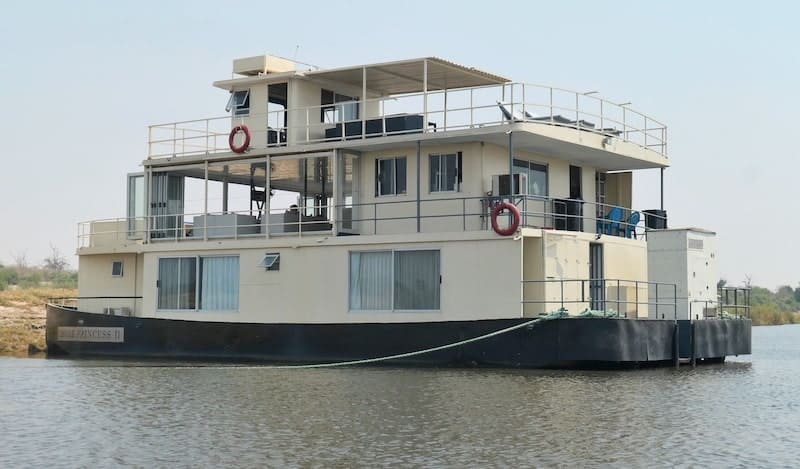
While elephants, hippos, crocodiles, buffalo, and various mammals were attention grabbers, I was surprised at how many bird species we encountered and what rich viewing opportunities they presented. The symbiotic relationship between several birds and animals was an eye-opener.
I took every photo with my point-and-shoot pocket camera, a Panasonic Lumix DC-ZS200. The fact that it’s compact represents a trade-off between packing light and acceptable images.
However, for dedicated bird watchers and photographers, there are other options. Numerous photography safaris with professional photographers and equipment teach the art of capturing wildlife and birdlife.
16 Remarkable birds of Chobe National Park
I was amazed at the diverse and abundant birdlife and how close our river tender could get to observe them in their natural habitat.
1. African darter
The African darter is an adept hunter, diving swiftly for fish it catches with its long, pointed bill. It can be seen swimming with only its slender neck above water as it stalks fish beneath the surface. Its swift diving habits and long neck have earned it the common name ‘snakebird.’
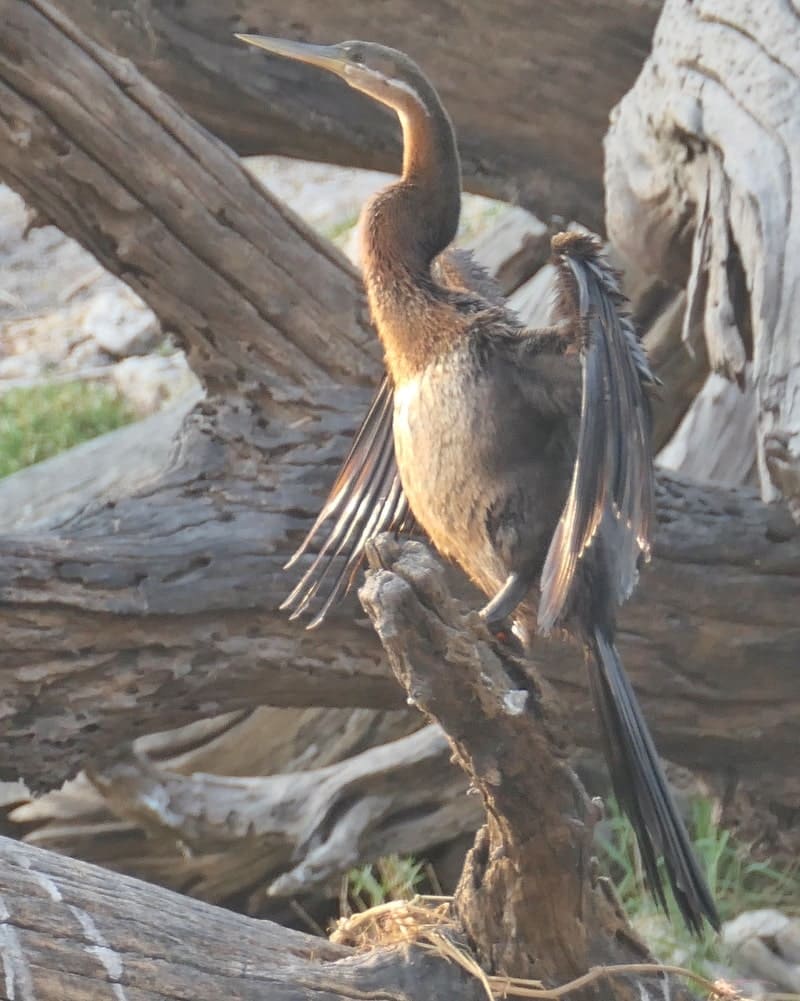 African darter, Chobe National Park
African darter, Chobe National Park
2. African fish eagle
Believed to mate for life, the strikingly white head and chest of the African fish eagle contrast against the rich brown body and wings. It feeds mainly on fish, snatching the prey from the water with its large, clawed talons that are barbed to assist in grabbing slippery catches. Observing it perched majestically on a tree branch or swooping to snap unsuspecting prey creates unforgettable moments.
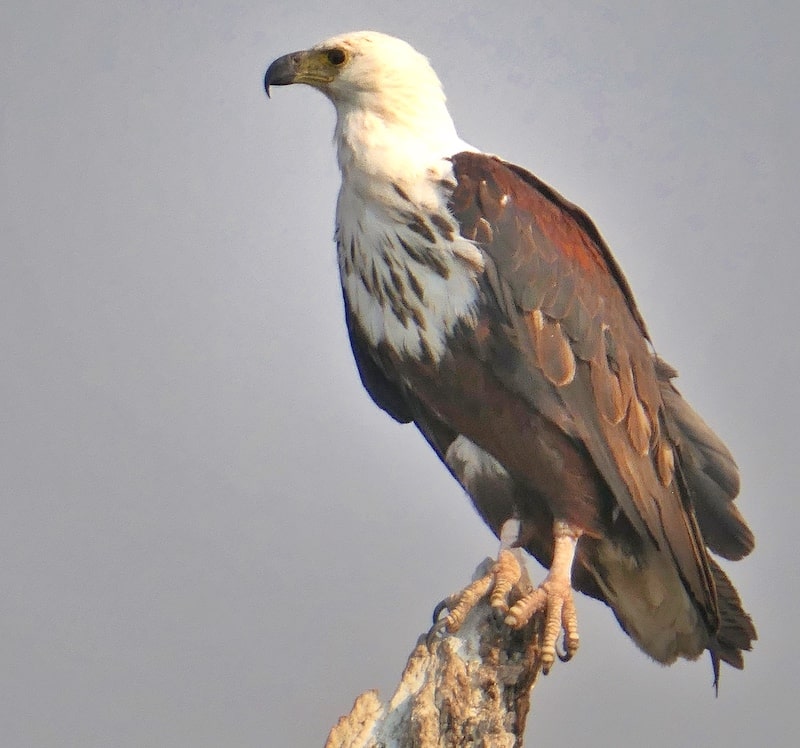 African fish eagle, Chobe National Park
African fish eagle, Chobe National Park
3. African jacana
The African jacana is a wading bird that feeds on insects and other invertebrates picked from floating vegetation or the water’s surface. It has long toes and claws, enabling it to walk gracefully on floating vegetation with balance and poise. As such, it may appear to walk on water, earning the moniker ‘Jesus Bird’ in some quarters.
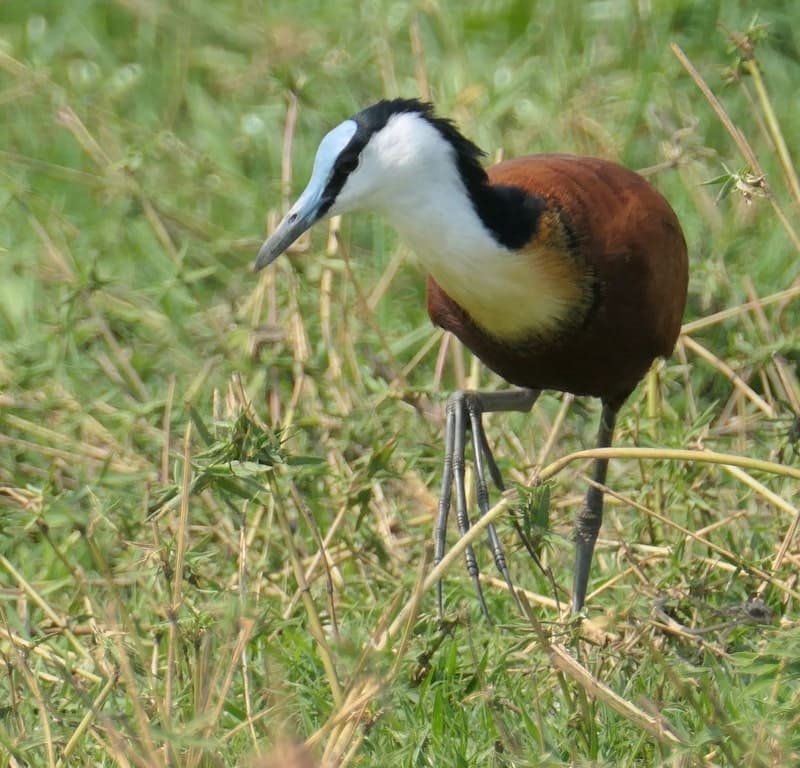 African jacana, Chobe National Park
African jacana, Chobe National Park
4. African skimmer
African skimmers’ favourite habitat is a sandbar. Their striking black and white plumage and bright red bills and legs contrast nicely with their habitat. The upper beak of the African Skimmer is shorter than the lower one. As the bird glides across calm waters, its knife-like lower beak skims the surface to snap up small, unwary fish.
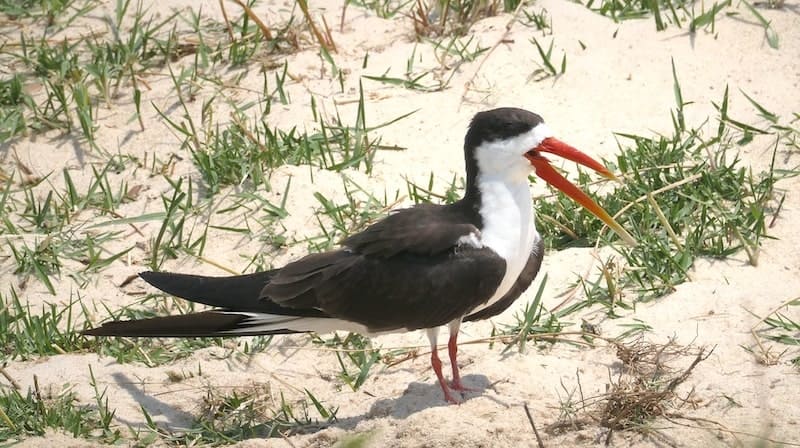 African skimmer, Chobe National Park
African skimmer, Chobe National Park
5. Black-crowned night heron
Black-crowned night herons are stocky birds compared to many of their long-limbed heron relatives. They’re most active at night or dusk, when you might see them leaving their roosts to forage for fish and frogs. In the light of day, adults are striking with their grey-and-black plumage, long white head plumes, and red eyes. These social birds breed in colonies of stick nests, usually built over water.
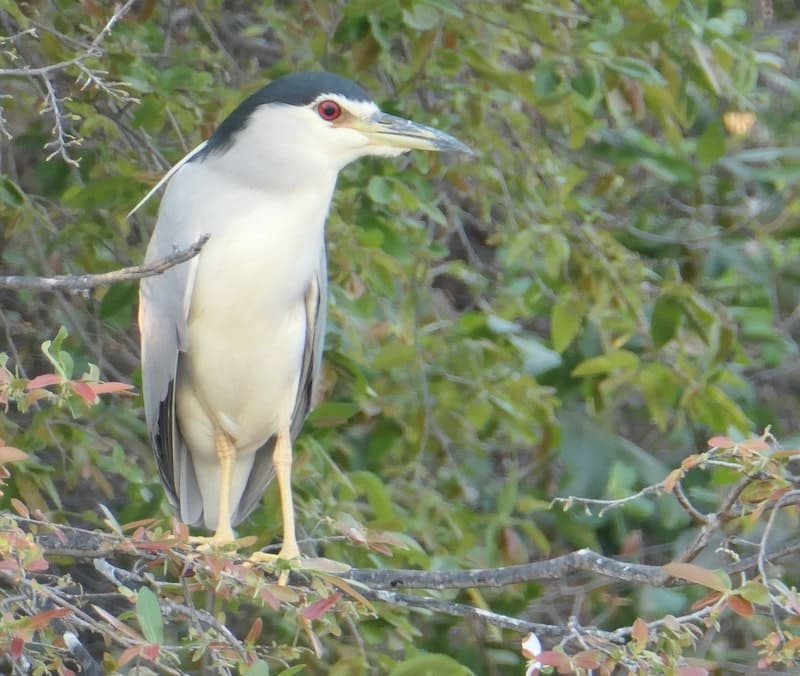 Black-crowned night heron, Chobe National Park
Black-crowned night heron, Chobe National Park
6. Black-winged stilt
With its thin, extra-long, coral-red legs and its needle-like thin bill, the black-winged stilt is an elegant and graceful wader. They eat mainly insects and crustaceans.
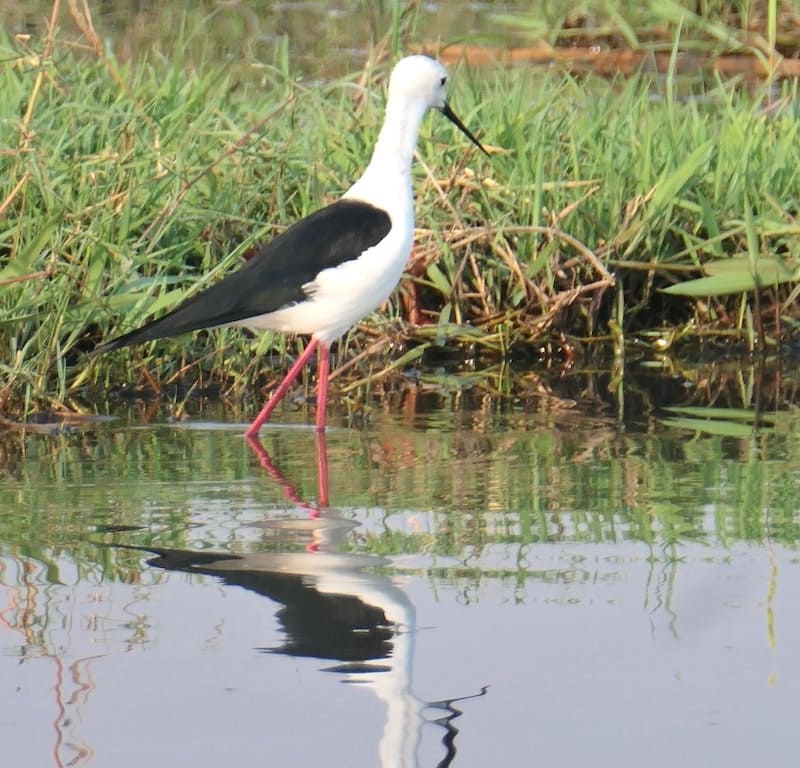 Black-winged stilt, Chobe National Park
Black-winged stilt, Chobe National Park
7. Grey heron
The grey heron is a long-legged, wading bird about a metre tall. It feeds mainly on aquatic creatures stalked by walking through the shallows or caught after standing stationary beside or in the water.
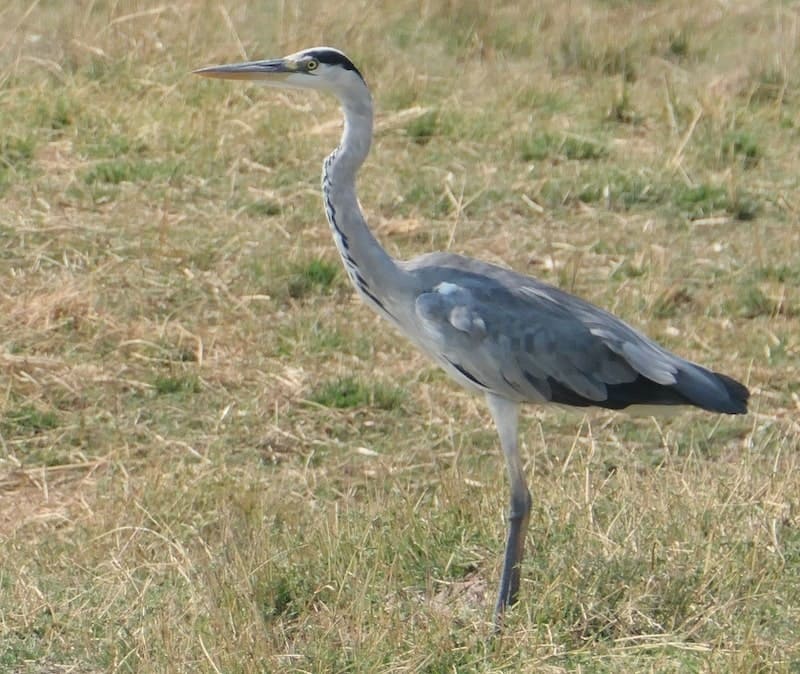 Grey heron, Chobe National Park
Grey heron, Chobe National Park
8. Malachite kingfisher
One of the most colourful birds in the park is the malachite kingfisher. This vivid, petite bird with a bright red beak and legs and a bright metallic blue crown is often spotted perched on reeds or low-hanging branches, patiently waiting for the next meal. It feeds on fish and aquatic insects.
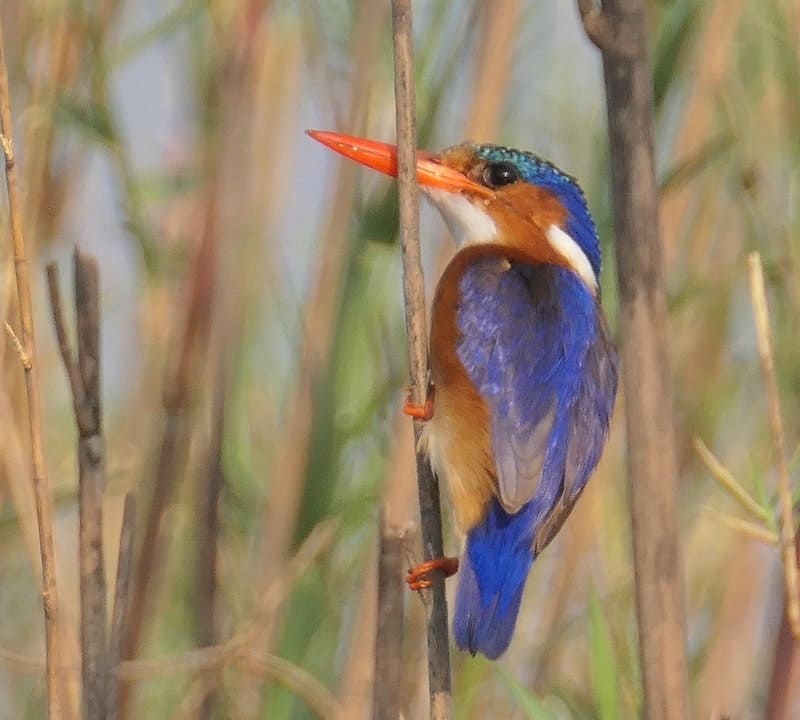 Malachite kingfisher, Chobe National Park
Malachite kingfisher, Chobe National Park
9. Pied kingfisher
The pied kingfisher is a striking black and white bird with a prominent crest and long, pointed bill. It is known for its impressive hunting skills, hovering above water before diving to catch fish. Kingfishers swallow small fish whole, usually headfirst. Larger fish must be bashed against a bough to kill and tenderize it to make it easier to swallow.
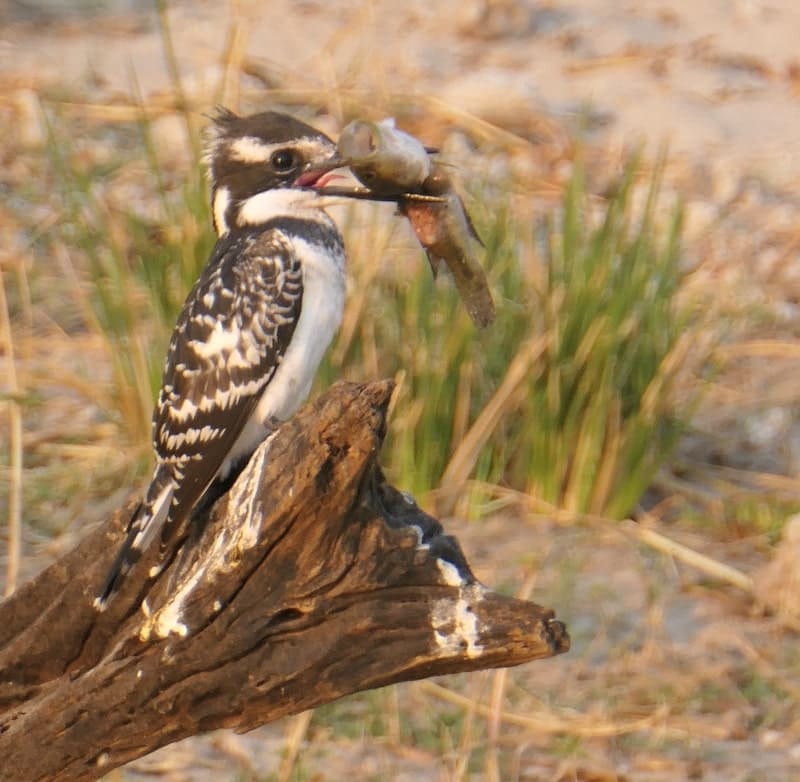 Pied kingfisher, Chobe National Park
Pied kingfisher, Chobe National Park
10. Red-billed oxpecker
Oxpeckers keep their hosts’ hides free of ticks and other parasites. These small, colourful birds have a symbiotic relationship with the hippopotamus, buffalo, elephant, and other large mammals. That such drastically different species can work together for mutual benefit is one of the wonders of the natural world. Spotting them perched on enormous creatures offers a ’birds-eye-view’ of an interesting wildlife interaction.
As well as ticks and other parasites, blood, mucus, dandruff, and ear wax make up the oxpeckers’ food source. As the birds feed, they help keep their hosts groomed. They also act as lookouts. When danger approaches, a hissing call warns its host to a potential and nearby predatory threat, thus allowing the host ample opportunity to fight or flee.
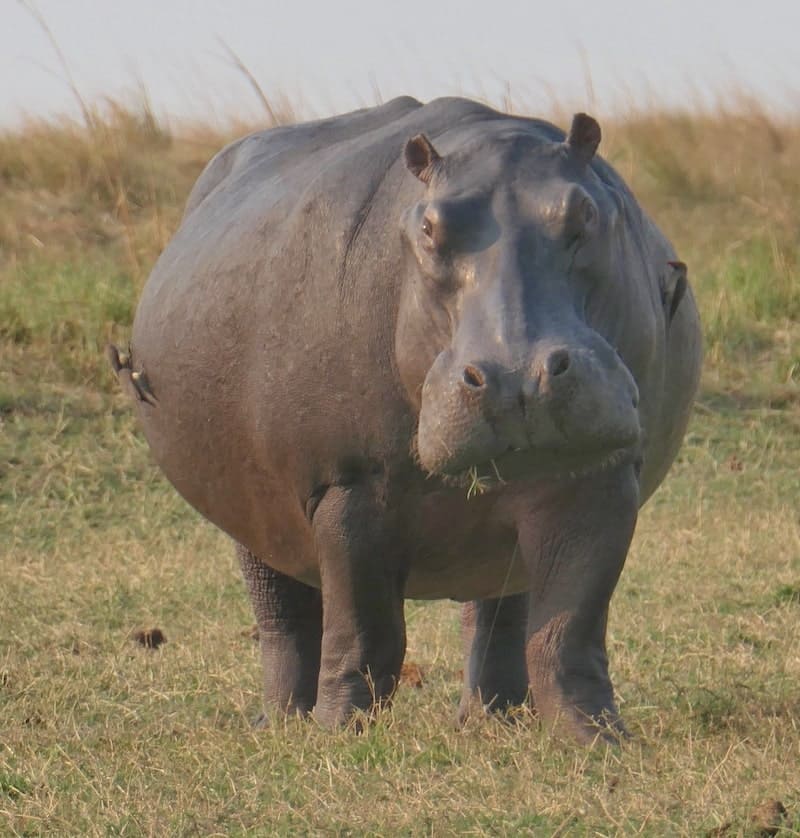 Red-billed oxpeckers on hippopotamus, Chobe National Park
Red-billed oxpeckers on hippopotamus, Chobe National Park
11. Water thick-knee
The water thick-knee is a plover-like bird with large, yellow eyes. It never wanders far from permanent water and needs bushes or nearby woodlands for shelter while it blends into the surroundings thanks to its grey-brown plumage. It feeds on insects, crustaceans, and mollusks.
It is a monogamous breeder with both parents guarding the nest and brooding the eggs. The nest is a simple scrape in sandy or stony ground. Both sexes incubate the eggs for 22-25 days, and both are responsible for feeding the young. Unique among birds, thick-knee pairs frequently nest adjacent to and sometimes directly on top of Nile crocodile nests. The two species share a symbiotic relationship, with the more energetic and vocal thick-knee functioning as loud sentries for the nests as the more powerful crocodile provides protection.
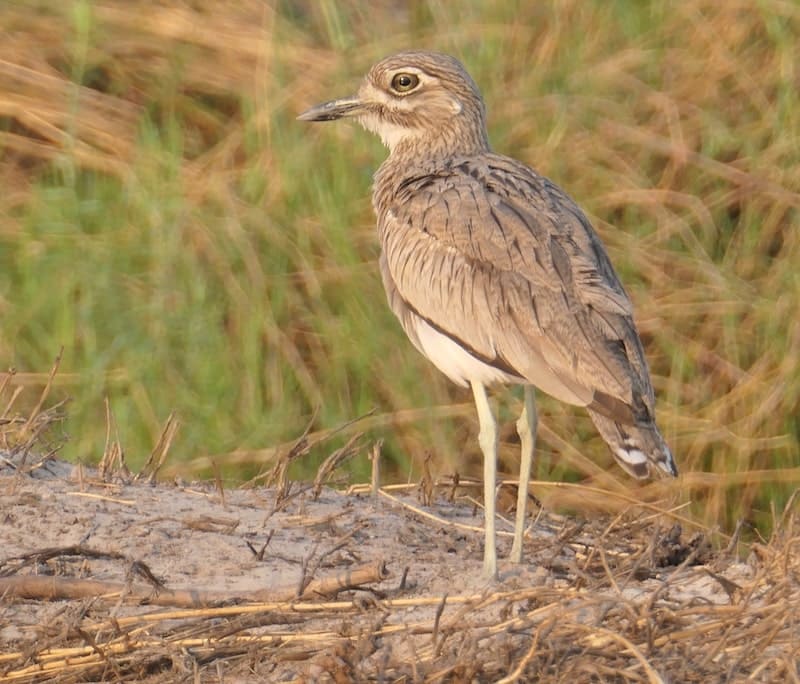 Water thick-knee, Chobe National Park
Water thick-knee, Chobe National Park
12. White-breasted cormorant
The white-breasted cormorant is the only form of great cormorant in sub-Saharan Africa. It’s much like the widespread great cormorant but distinguishable by its white breast and throat. This adept fisher is often seen perched on rocks or trees near water, waiting to dive beneath the surface to catch its prey. Diving to a depth of up to ten metres, it feeds on fish, crustaceans, and occasionally molluscs. It pursues its prey by swimming underwater, grabbing it in the bill, and usually swallowing it immediately, depending on the size. Larger prey is taken back to the shore to be eaten.
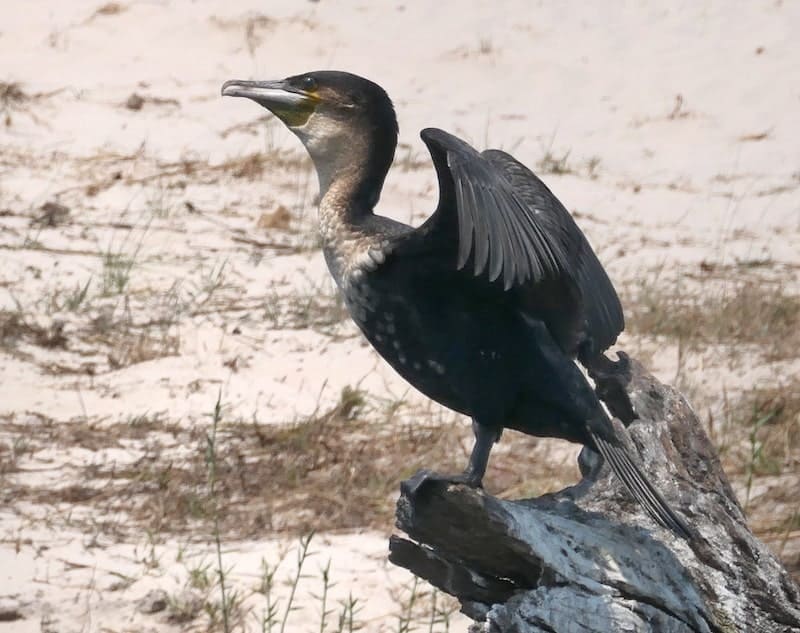 White-breasted cormorant, Chobe National Park
White-breasted cormorant, Chobe National Park
13. White-crowned lapwing
The white-crowned lapwing is best identified by its long yellow wattles, white belly, and grey head split down the centre by a broad white crown stripe. In flight, the distinctive wings are almost entirely white with black tips. It forages near water for beetles, wasps, worms, crabs, small fish, and frogs.
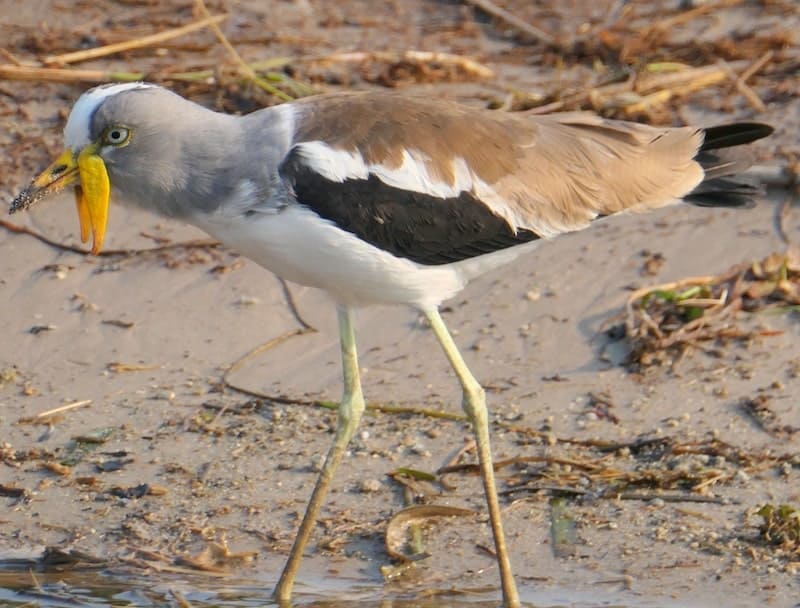 White-crowned lapwing, Chobe National Park
White-crowned lapwing, Chobe National Park
14. White-fronted bee-eater
With its vibrant green plumage and distinct black mask, this stunning species can be seen perched on branches or other vegetation near riverbanks, where they hunt for bees and other flying insects such as wasps, dragonflies, butterflies, and flies. Their remarkable aerial displays demonstrate their exceptional agility while hunting in flight. Kingfishers and bee-eaters nest in small burrows on the riverbank. They breed during the dry season as the bank is covered in water during the wet season.
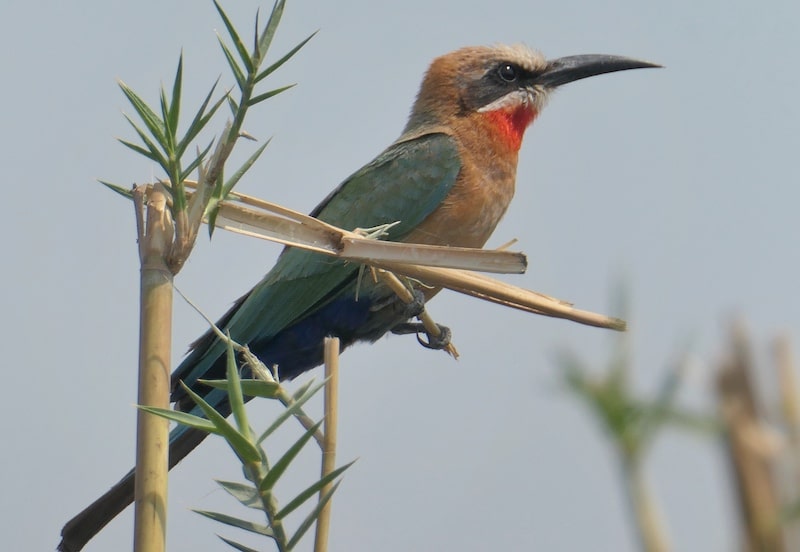 White-frontede bee-eater, Chobe National Park
White-frontede bee-eater, Chobe National Park
15. Wire-tailed swallow
The wire-tailed swallow is another bird that performs fascinating aerial acrobatics as it feeds on airborne insects. With its iridescent blue-black upper parts and distinct long, slender, forked tail feathers, it’s a delight to watch as it swoops and darts in pursuit of flying insects. On one of our river drives, a wire-tailed swallow hitched a ride on our tender by sneaking into a cozy spot under the canopy.
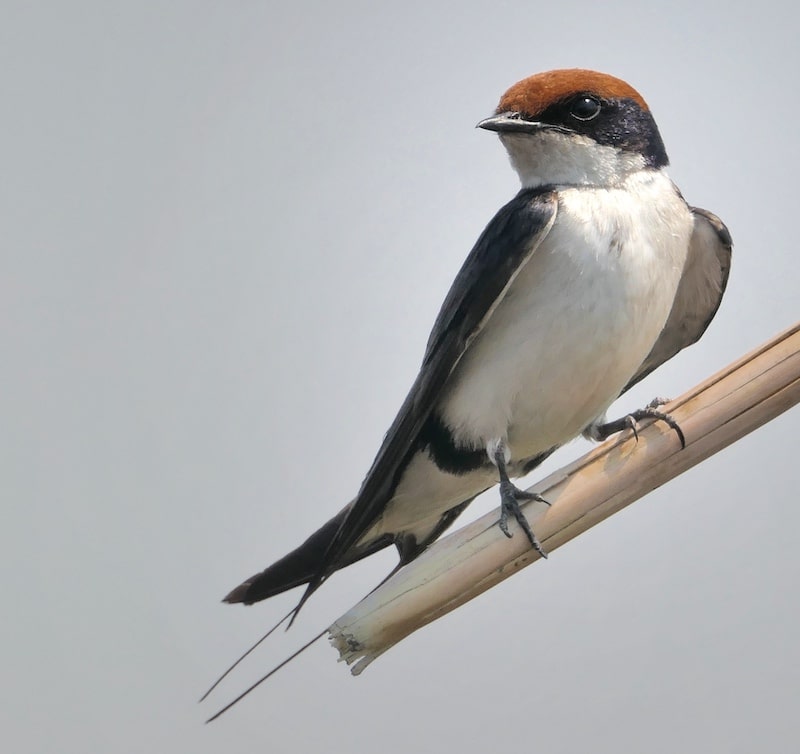 Wire-tailed swallow, Chobe National Park
Wire-tailed swallow, Chobe National Park
16. Yellow-billed stork
With its strikingly colourful beak and elegant posture, the yellow-billed stork can often be spotted wading gracefully through the park’s waterways, using its long bill to hunt for fish and crustaceans.
Yellow-billed storks prefer wetland habitats, where they partially open their bills in the muddy waters while searching for food. Sometimes, they submerge their entire heads or follow hippopotamuses and crocodiles to capture potential prey that the larger animals have disturbed.
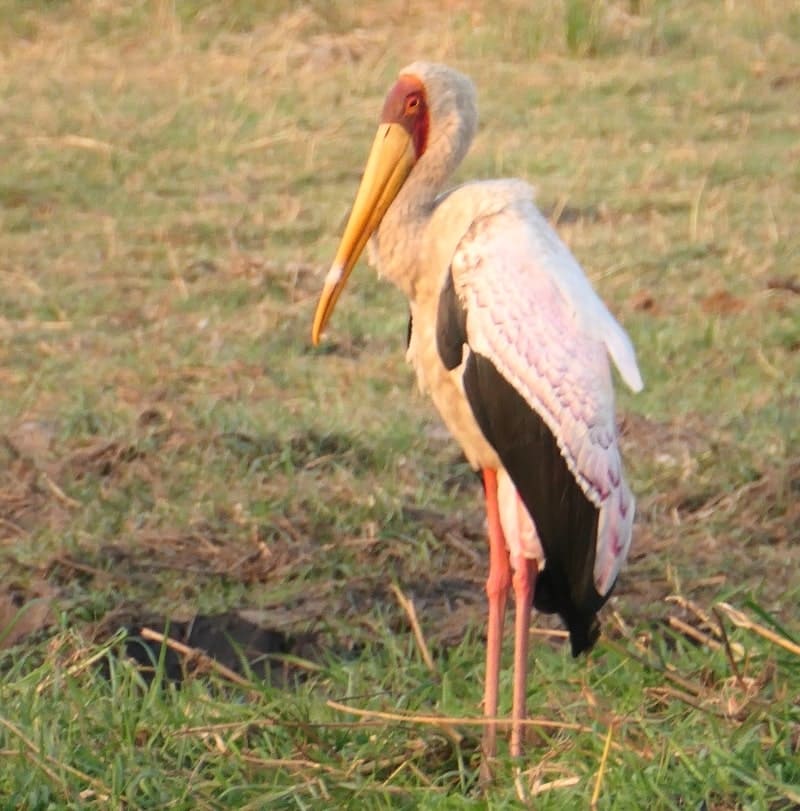 Yellow-billed stork, Chobe National Park
Yellow-billed stork, Chobe National Park
The verdict?
If you’re a birdwatcher, head to the Chobe National Park. If you aren’t, head there anyway. You’ll undoubtedly appreciate the diverse selection of birds of Chobe National Park interspersed with exciting sightings of elephants, hippos, crocodiles, and other reptiles and mammals that make the Chobe River famous.
If you’re planning a trip to Africa and a safari is on your travel list, you might be interested in my post 11 Tips on choosing an African safari that describes the water-based safari in Botswana and a land safari in South Africa.
If you found this post helpful, please share it by selecting one or more social media buttons. If you’ve visited Chobe National Park or have thoughts on this post, please share them in the comments. Thank you.
Care to pin it for later?
